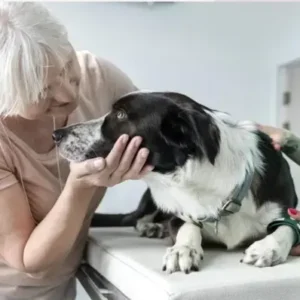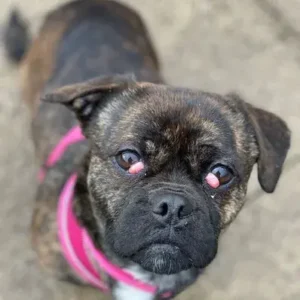Types of Demodectic Mange
Demodectic mange is itself a type of mange that can vary in severity. While some cases remain mild and localized, others can spread and become more serious. Understanding the different types of Demodectic mange can help dog owners determine the best course of action for treatment.
- Localized Demodectic Mange – Affects only a few small areas, usually on the face or legs. It often clears up on its own.
- Generalized Demodectic Mange – A more severe form that spreads across the body, requiring medical treatment.
Symptoms of Demodectic Mange in Dogs
Recognizing the symptoms of demodectic mange early can help prevent the condition from worsening. While some dogs with demodectic mange may experience mild irritation, others may develop severe skin infections if left untreated.
Common clinical signs of demodectic mange include:
- Patchy hair loss (alopecia), especially around the face, legs, and trunk
- Red, inflamed, or scaly skin
- Excessive itching and discomfort
- Secondary skin infections, leading to pus, crusty sores, and a foul odor
- Thickened or darkened skin in chronic cases
Causes and Risk Factors
Demodex mites are present in all dogs, but certain factors can trigger an outbreak:
- Weakened immune system – Common in puppies, adult dogs, or those with underlying health conditions
- Genetic predisposition – Some dog breeds, like Bulldog, Shar-Pei, and Doberman, are more prone
- Poor nutrition – Malnourished dogs have weaker immune defenses
- Stress and anxiety – High-stress environments can suppress the immune system
- Hormonal imbalances – Conditions like hypothyroidism may increase susceptibility
How is Demodectic Mange Diagnosed?
A veterinarian will perform the following tests to confirm demodectic mange:
- Skin scraping test – Examining skin samples under a microscope to detect Demodex mites
- Hair pluck test – Checking hair follicles for mite infestation
- Biopsy – In severe cases, a skin biopsy may be needed to rule out other skin conditions
Treatment Options for Demodectic Mange
Treatment depends on the severity of the mange and whether secondary infections are present.
Medications
- Topical treatments – Medicated shampoos, dips, and ointments containing benzoyl peroxide or amitraz
- Oral medications – Ivermectin, milbemycin, or fluralaner-based drugs prescribed by a vet
- Antibiotics – If secondary bacterial infections develop
- Anti-inflammatory treatments – To reduce itching and irritation
Home Remedies (Consult your vet before using)
- Coconut oil – Has antimicrobial and soothing properties
- Apple cider vinegar (diluted) – May help balance skin pH and fight bacteria
- Aloe vera gel – Provides relief from irritation and redness
Strengthening the Immune System
- Nutritious diet – Rich in vitamins, omega-3 fatty acids, and high-quality proteins
- Regular exercise – Helps maintain overall health and immune function
- Reducing stress – A calm environment supports immune health
Can Demodectic Mange Be Prevented?
While not always preventable, you can reduce the risk by:
- Feeding a balanced diet to support immune health
- Keeping up with routine veterinary check-ups
- Practicing good hygiene and regular grooming
- Minimizing stress in your dog’s environment
Is Demodectic Mange Contagious?
Unlike sarcoptic mange, demodectic mange is not contagious to other dogs or humans. However, puppies can inherit mites from their mothers during nursing.
When to See a Vet
Seek veterinary care if your dog:
- Has widespread hair loss and red, irritated skin
- Develops pus-filled sores or a foul-smelling infection
- Does not show improvement with home care








